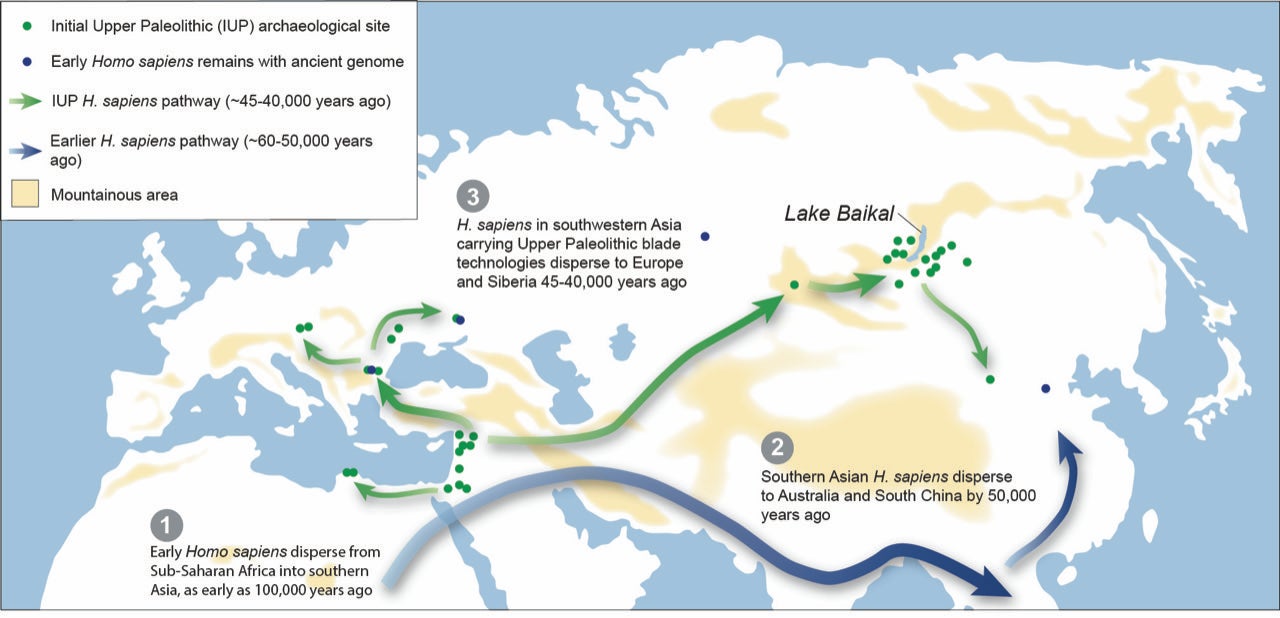There’s a recurring mystery surrounding early human migration: Exactly when did Homo sapiens make their way from Africa into Europe and Asia? It’s possible that a period of warmer temperatures could have contributed to this flow of people into Eurasia, according to a study published September 22 in the journal Science Advances. Warmer temperatures and more humidity may have helped the forests in the region grow and expand north into present-day Siberia. The theory hinges on the presence of pollen in the region’s sediment record. The scourge of modern day spring allergy sufferers could have laid the groundwork for our very distant ancestors’ migration into Eurasia.
[Related: Humans and Neanderthals could have lived together even earlier than we thought.]
This movement could have begun in three waves into Eurasia about 54,000 years ago. It is also likely that both warm and cold climates would have played a role in this travel. The Pleistocene Epoch is known for huge climatic shifts, including the formation of the massive ice sheets and glaciers that would eventually forge and shape many of the landforms we see on Earth today.
To piece together what the climate could have looked like during a possible warm period about 45,000 to 50,000 years ago, researchers working on the study created a record of the vegetation and pollen from the Pleistocene found around Lake Baikal in present-day Siberian region of Russia with the oldest archeological traces of Homo sapiens in the area.
Sediment cores were used to extract data for a pollen timeline, and the study suggests that the dispersal of humans occurred during some of the highest temperatures and highest humidity of the late Pleistocene. The presence of more ancient pollen, and thus plant life, in the record shows evidence that coniferous forests and grasslands may have spread further throughout the region and could support foraging for food and hunting by humans. According to study author and University of Kansas anthropologist Ted Goebel, the environmental data combined with archeological evidence tell a new story of the area.
“This contradicts some recent archaeological perspectives in Europe. The key factor here is accurate dating, not just of human fossils and animal bones associated with the archaeology of these people, but also of environmental records, including from pollen,” Goebel said in a statement. “What we have presented is a robust chronology of environmental changes in Lake Baikal during this time period, complemented by a well-dated archaeological record of Homo sapiens’ presence in the region.”
 A map of theorized migration routes of early Homo sapiens from Africa across Eurasia. CREDIT: Ted Goebel.
A map of theorized migration routes of early Homo sapiens from Africa across Eurasia. CREDIT: Ted Goebel.
Goebel worked with teams from three institutions in Japan, including Masami Izuho of Tokyo Metropolitan University. During the pollen analysis, the team found some potential connections between the pollen data and the archeological record of early human migration into the region. The early modern humans of this period were making stone tools on slender blands and using bones, antlers, and even ivory to craft the tools.
“There is one human fossil from Siberia, although not from Lake Baikal but farther west, at a place called Ust’-Ishim,” Goebel said. “Morphologically, it is human, but more importantly, it’s exceptionally well-preserved. It has been directly radiocarbon-dated and has yielded ancient DNA, confirming it as a representative of modern Homo sapiens, distinct from Neanderthals or Denisovans, or other pre-modern archaic humans.”
[Related: World’s oldest known wooden structure pre-dates our species.]
It’s possible that the earliest humans in the area likely would have lived in extended nuclear families, but it is difficult to say with certainty since so much archeological evidence has degraded over time. Ust’-Ishim in Siberia provides the earliest known evidence of fully modern humans coexisting with other extinct human species in the area, but the find was an “isolated discovery,” according to the team.
“We lack information about its archaeological context, whether it was part of a settlement or simply a solitary bone washed downstream,” said Goebel. “Consequently, linking that single individual to the archaeological sites in the Baikal region is tenuous—do they represent the same population? We think so, but definitely need more evidence.”

>>> Read full article>>>
Copyright for syndicated content belongs to the linked Source : Popular Science – https://www.popsci.com/science/pollen-human-migration/































